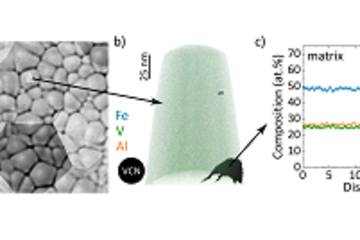All genres
2381.
Thesis - PhD
Microstructure alterations in bearing steels exposed to severe plastic deformation. Dissertation, RWTH Aachen University (2020)
2382.
Thesis - PhD
Design of materials with anomalous thermophysical properties and desorption-assisted phase formation of intermetallic thin films. Dissertation, RWTH Aachen University (2020)
2383.
Thesis - PhD
Microstructural Relationships of Strength and Ductility in a Newly Developed Mg–Al–Zn Alloy for Potential Automotive Applications. Dissertation, RWTH Aachen University (2020)
2384.
Thesis - PhD
Microstructural Relationships of Strength and Ductility in a Newly Developed Mg–Al–Zn Alloy for Po-tential Automotive Applications. Dissertation, RWTH Aachen University (2020)
2385.
Thesis - PhD
Precipitation Reactions During the Intrinsic Heat Treatment of Laser Additive Manufacturing. Dissertation, RWTH Aachen University (2019)
2386.
Thesis - PhD
Deformation behaviour and texture memory effect of multiphase nano-laminate medium manganese steels. Dissertation, RWTH Aachen University (2019)
2387.
Thesis - PhD
On the interfacial defect formation mechanism during laser additive manufac-turing of polycrystalline superalloys. Dissertation, Ruhr-Universität Bochum (2019)
2388.
Thesis - PhD
A study on low-cycle fatigue behaviour of high-manganese steels. Dissertation, RWTH Aachen University (2019)
2389.
Thesis - PhD
Segregation and precipitation at interfaces in a model Al–Zn–Mg–Cu alloy. Dissertation, RWTH Aachen University (2019)
2390.
Thesis - PhD
On the interfacial defect formation mechanism during laser additive manufacturing of polycrystalline superalloys. Dissertation, Ruhr-Universität Bochum (2019)
2391.
Thesis - PhD
Challenges and opportunities associated to the characterization of H/D in Ti and its alloys with atom probe tomography. Dissertation, RWTH Aachen University (2019)
2392.
Thesis - PhD
Laser Additive Manufacturing of Oxide Dispersion Strengthened Steels and Cu–Cr–Nb Alloys. Dissertation, RWTH Aachen University (2019)
2393.
Thesis - PhD
Damage and Strain Patterning Simulation of Structural Heterogeneity. Dissertation, RWTH Aachen University (2019)
2394.
Thesis - PhD
On chemically sensitive atomic scale imaging. Dissertation, Ruhr-Universität Bochum, Bochum, Germany (2018)
2395.
Thesis - PhD
Phase nucleation through confined spinodal fluctuations at crystal defects in Fe–Mn alloys. Dissertation, RWTH, Aachen, Germany (2018)
2396.
Thesis - PhD
Microstructural influence on micro-damage initiation in ferritic-martensitic DP-steels. Dissertation, RWTH Aachen, Aachen, Germany (2018)
2397.
Thesis - PhD
Damage nucleation in DP-steels: experimental characterization of the contributing microstructural parameters. Dissertation, Fakultät für Georessourcen und Materialtechnik, RWTH Aachen (2018)
2398.
Thesis - PhD
Nano-scale investigation of the degradation mechanism of multilayer protective coating for precision glass molding. Dissertation, RWTH Aachen, Aachen, Germany (2018)
2399.
Thesis - PhD
Synthese und Eigenschaften flexibler Resorcin-Formaldehyd- und Kohlenstoffaerogele. Dissertation, RWTH Aachen, Aachen, Germany (2018)
2400.
Thesis - PhD
Deformation mechanisms and the role of interfaces in face-centered cubic Fe-Mn-C micro-pillars. Dissertation, RWTH Aachen, Aachen, Germany (2018)











